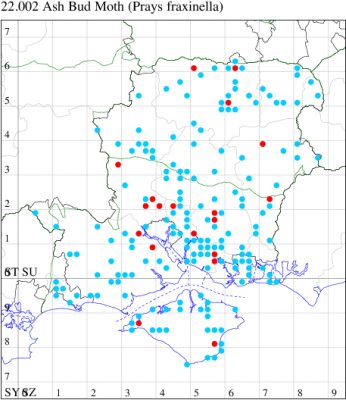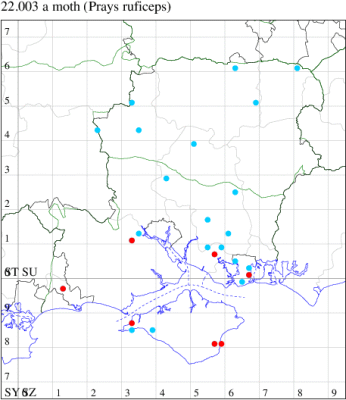2021 Annual Report for: Praydidae / Praydinae
For species seen in 2021 that had less than or equal to 100 records, full details are included; for more common species, the earliest, latest and highest count by vice-county are shown. The narrative for each species is taken from the main Hantsmoths website, and it is possible that some information on abundance and occurrence can get out of date, as it is impossible to keep up with all changes; however it should give a good introduction to each species. The tables in each species account summarise the previous status, and that for the current year.
For the maps, all records prior to 2021 are shown by a blue dot (the larger the dot, the more recent), with the current year's records shown in red. As previous records are superimposed on any report for 2021, new sites have greater emphasis (i.e. will show as 'more red').
In the species accounts, an asterisk next to a location indicates a new 10km square record; earliest ever dates are highlighted in orange, and latest ever in red. Initials in the species accounts refer to the recorders listed here. Please get in touch if you identify any omissions or errors, in particular if you have records that have yet to be submitted. Details of how to submit records can be found here.
22.002 [B&F: 0449] Ash Bud Moth Prays fraxinella (Bjerkander, 1784) - Common
Common wherever there are ash trees throughout most of the British Isles. Widespread and common in Hampshire and on the Isle of Wight. Wingspan 14-17 mm. The typical form is distinctive and easy to recognise, less so the dark form rustica, which is considered to be a separate species by some authors. Larva mines leaves and bark of Ash, subsequently burrowing into and feeding on branches.
Records prior to 2021
| Vice County | #Records | #Individuals | First Record | Last Record |
|---|---|---|---|---|
| 10 | 96 | 96 | 1893 | 2020 |
| 11 | 531 | 581 | 1973 | 2020 |
| 12 | 184 | 218 | 1975 | 2020 |
2021 records
| Vice County | #Records | #Individuals | Max Quantity |
|---|---|---|---|
| 10 | 2 | 3 | 2 |
| 11 | 27 | 28 | 2 |
| 12 | 4 | 4 | 1 |

Records by year
Records by week (adult)
Records by week (larval)
Record Details
VC10: Freshwater, one, 27 Jun (PBar); Shanklin, two, 02 Jul (IOut);
VC11: Broughton Down, one, 12 Jun (MBot); Marchwood, one, 20 Jun; one, 24 Jul; one, 26 Jul (CTha); Totton, one, 30 Jun; one, 08 Jul; two, 18 Jul; two, 21 Jul; one, 22 Jul; one, 29 Aug (LHan); Romsey, one, 30 Jun; one, 07 Jul (MBak); one, 23 Jun; one, 14 Jul (NRJ); Valley Park, Chandlers Ford, one, 21 Jul; one, 22 Jul (KArb); Allbrook, one, 30 Jun; one, 18 Jul; one, 20 Jul (SIng); Fareham, one, 20 Aug (IMcP); one, 01 Jul; one, 08 Jul; one, 15 Aug (MLO); Botley, one, 20 Aug (SLB); Hilltop, The Hangers, one, 12 Jun (SIng det. DPH); Upper Swanmore, present, field observation, 30 Jun (DTru); Petersfield, one, 24 Jun (RAll);
VC12: Ecchinswell, one, 17 Jul (MJN); Basingstoke, one, 18 Jul (RHil); Pamber Forest, one, 24 Jun (GJD); Alton, one, 05 Aug (DBO)
22.003 [B&F: 0448a] Prays ruficeps (Heinemann, 1854) - Common
Wingspan 14-17 mm. Originally thought a dark form of Prays fraxinella , DNA bar coding has indicated that P. ruficeps is a species distinct in its own right. P.fraxinella does have a dark form but in it the faint "fraxinella" markings of the normal, black and white form can still be distinguished. Prays ruficeps is uniformly dark brown/blackish with an orangey red head. Old records of the so-called f. rustica of fraxinella could refer to either, so its historic status is unknowable. The larva feeds on Ash.
Records prior to 2021
| Vice County | #Records | #Individuals | First Record | Last Record |
|---|---|---|---|---|
| 10 | 21 | 29 | 2017 | 2020 |
| 11 | 87 | 90 | 1981 | 2020 |
| 12 | 17 | 29 | 2011 | 2020 |
2021 records
| Vice County | #Records | #Individuals | Max Quantity |
|---|---|---|---|
| 10 | 6 | 8 | 3 |
| 11 | 5 | 4 | 1 |

Records by year
Records by week (adult)
Records by week (larval)
Record Details
VC10: Totland, one, 02 Sep (RTer); Shanklin, one, 19 Jul; one, 04 Aug; one, 20 Aug; Shanklin Upper Chine, three, 18 Jul; one, 21 Jul (IOut);
VC11: Woodlands, NF*, present, 26 Jul (RBW); Fareham, one, 09 Sep (MLO); Portsmouth, one, 19 Jul (IRT); Hurn, one, 09 Jun; one, 10 Aug (MJef)